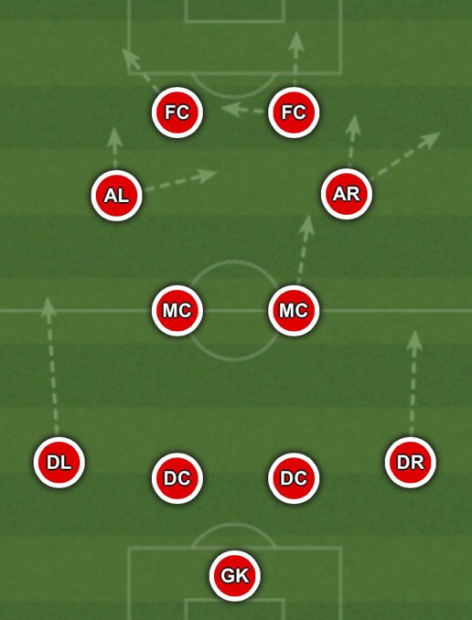When the biggest podcast regarding German football in Sweden decided to predict Bundesliga, I said that Leverkusen were going to finish 16th. 19 games in and I just can’t remember what the hell I was thinking back in August. I must have thought that Leverkusen’s weak yesteryear was not an exception, but a rule and that the appointment of coach Heiko Herrlich was only going to send them even further down the pecking order. One could forgive me for thinking that. Bayer Leverkusen were one of the big disappointments of last season and having sold both Kevin Kampl and Chicarito, things looked dire in the small town just north of Cologne.
However, the tactical flexibility that Herrlich has brought with him from Regensburg has proven vital and Leverkusen now sit at second, spear-heading a bunch of even teams behind Jupp Heynckes’ Bayern. So I decided to sit down to watch their tactics more closely in their game against Hoffenheim, another very interesting team tactically who under coach Nagelsmann have had a revival.
The game started off just like I had expected, with lots of possession and control from both sides, but mainly from Nagelsmann’s Hoffenheim. After all, that has become his signature. Heiko Herrlich and his Werkself were adamant in defence however and when they managed to get the ball back they kept it really well and mixed possession with the classic Leverkusen counter attacks that we’ve come to love. It looked like it would be an evenly contested game between two control freaks where one team had the ball and the other tried to get the ball back through directed pressing.
Hoffenheim fielded a 5-3-2 with wing backs who had license to roam. Both Kaderabek and Steven Zuber, right wing back and left wing back respectively, were supposed to be the outlets on the flanks. In midfield Nagelsmann deployed an attacking duo of Lukas Rupp and Dennis Geiger in front of Florian Grillitsch. Grillitsch’ role was of great importance as always for Hoffenheim. Being the main playmaker from deep, Grillitsch was supposed to be distributing balls to the wing backs and the more attacking midfielders Rupp and Geiger. This made it possible for the latter two to be more expressive in attack, knowing that Grillitsch covered for them both in and out of possession. In attack, Nagelsmann’s Hoffenheim had two strikers, Serge Gnabry and Adam Szalai. However, due to Serge Gnabry’s nature as a winger, he tended to drift wide to allow the central midfielders Rupp and Geiger more space in front of Leverkusen’s defence. Gnabry was supposed to drift wide in both directions while also providing support for the target man Szalai. When pressing, Hoffenheim used the very well-coveted pendulum principle. When Kaderabek went up to press Leverkusen’s left flank, the right defender covered the space behind him. This formed a back line of four behind the pressing wing back, while the midfielder on that side also provided support in the frenetic Hoffenheim pressing.

Hoffenheim’s 5-3-2 (Baumann- Kaderabek, Bicakcic, Vogt, Hübner, Zuber- Grillitsch- Geiger, Rupp- Szalai, Gnabry)
Leverkusen’s goal wasn’t unexpected in any way. Hoffenheim had had a few good chances, midfield dynamo Dennis Geiger hit the crossbar with a deflected effort for example, but Leverkusen looked extremely dangerous on the counters. Having deployed a 4-2-2-2 with dynamic wing backs and two defensively minded midfielder they had both stability and the ability to overload in attack. This together with Brandt and Leon Bailey behind Volland and Alario and you have a very potent attack, especially on the counter. Julian Brandt’s role in Leverkusen’s build up and general play was of great importance and he was one of the main reasons behind their first half goal, even though Leon Bailey stood for the finish (and what a finish it was). Towards the end of the first half Leverkusen looked in control. Baumgartlinger and Aranguiz took turns on marking Hoffenheim’s two more attacking midfielders while Julian Brandt and Leon Bailey marked and covered Hoffenheim’s defensively minded playmaker Florian Grillitsch. This narrowed things for Leverkusen, but it seems like this was the plan all along.

Leverkusen’s 4-2-2-2 (Leno- Henrichs, Bender, Tah, Wendell- Ch. Aranguiz, Baumgartlinger- Brandt, Bailey- Volland, Alario)
In the second half the directed marking and pressing became more obvious. It seemed like Leverkusen more or less let Hoffenheim play along the flanks, while guarding both their own box and the middle. This made it possible for both Kaderabek and Zuber, Hoffenheim’s two wing backs, to get to crossing positions further up the pitch. Moreover, this also meant that Leverkusen could exploit the space behind these two on the counters. Marking the middle in order to direct Hoffenheim out wide seemed to be the game plan for Herrrlich and Leverkusen and this worked wonders, especially in the second half.
While Bailey and Brandt marked eventual passing options in the middle when Hoffenheim were in possession, they quickly drifted out wide when Hoffenheim lost control of the ball, either through a misplaced cross or by getting dispossessed, to be able to counter attack right away. Leverkusen absorbed pressure and then attacked where Hoffenheim were weak. Incredibly clever by Heiko Herrlich who must have seen that Hoffenheim were quite stale and dull up top. Szalai isn’t the best striker and Gnabry is not att all good in the air. Thus, forcing crosses and then using the exposed flanks to counter attack an overload was a great and successful tactic.
Leverkusen finished the game as winners, 4-1, and currently sit in second after 19 games played. A few players stood out for them in the game against a very strong opposition. Leon Bailey was the star man of the afternoon. His role as an inverted winger, operating in the half-spaces, was perfect for him in this particular game and key to Leverkusen’s performance. However, Julian Baumgartlinger and Julian Brandt also played very well and should be applauded for their actions on the pitch. Brandt’s role as similar to Bailey’s in that he operated in the half-spaces. Moreover, Brandt was more of a pure winger, often drifting wide to create space for the inverted Leon Bailey and for Kevin Volland and even Charles Aranguiz who had the tendency to join the attacks. Baumgartlinger was the perfect stopper in midfield, stopping lots of attacks, while still possessing good enough understanding to be able to distribute the ball to different areas of the pitch. His marking and support in the middle of the pitch was also crucial to Leverkusen’s apparent game plan. He scored a goal as well and it seems like he’s finally performing the way he did at Mainz.
Heiko Herrlich is tactically flexible. He can change his tactics any way he pleases and that is what makes him and Leverkusen so very dangerously potent. They also have some amazing quality both in goal and up front with the future superstar Leon Bailey spearheading their attack. If Leverkusen can keep their players and build on this, then the name ”Neverkusen” could soon become ”Everkusen”.
